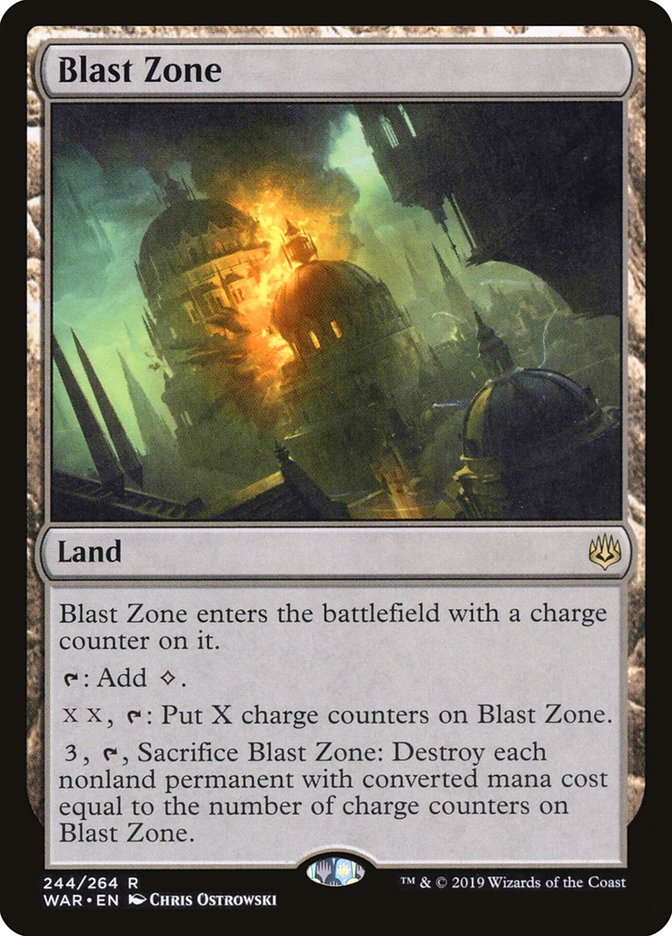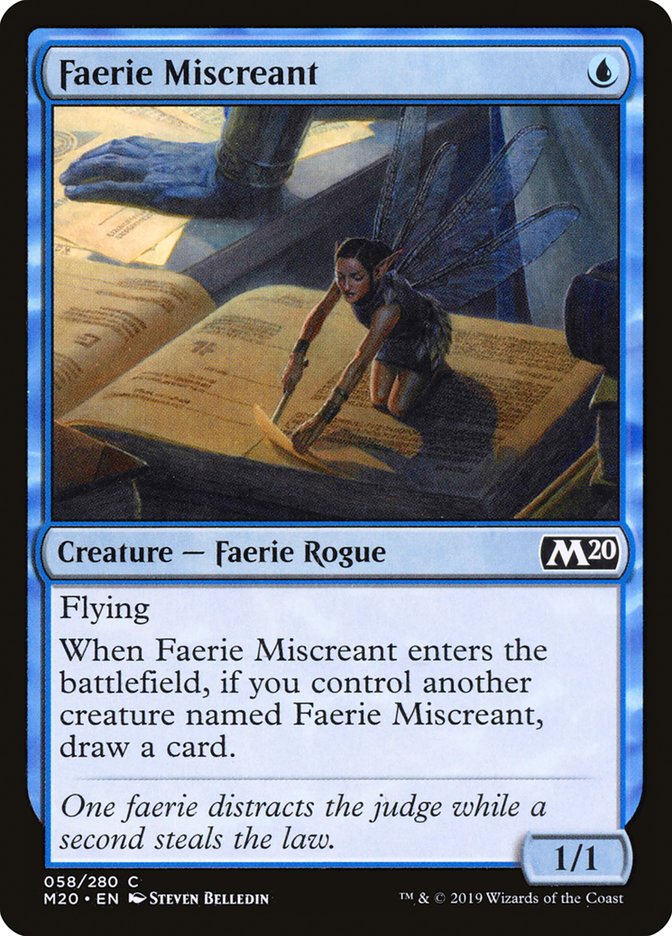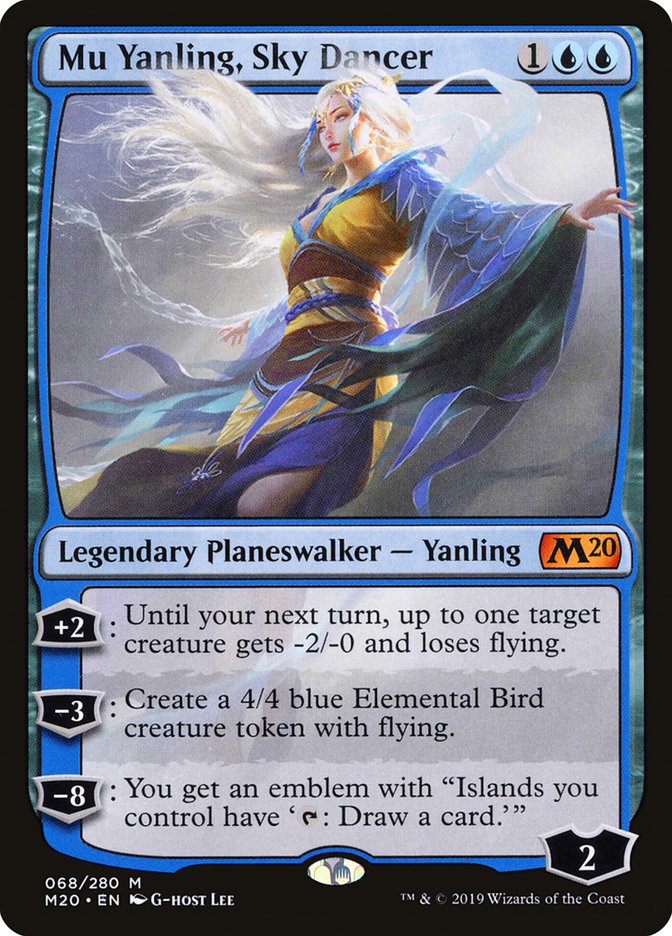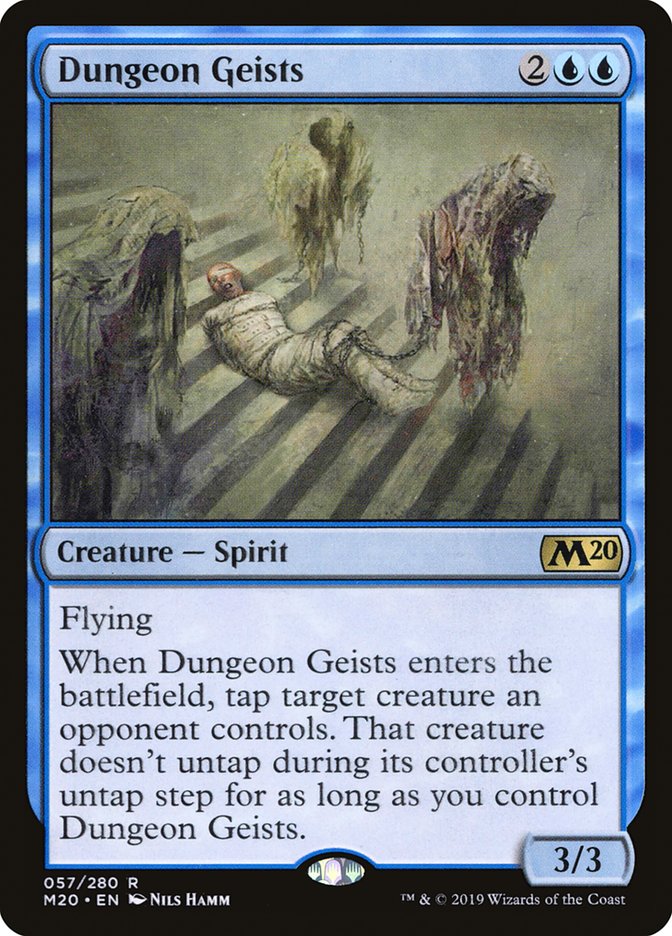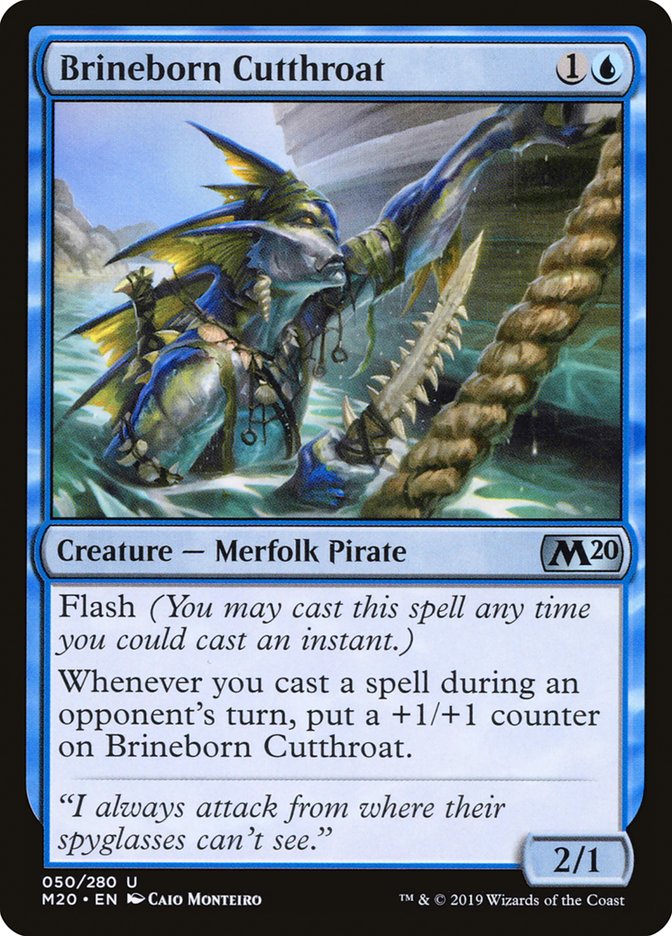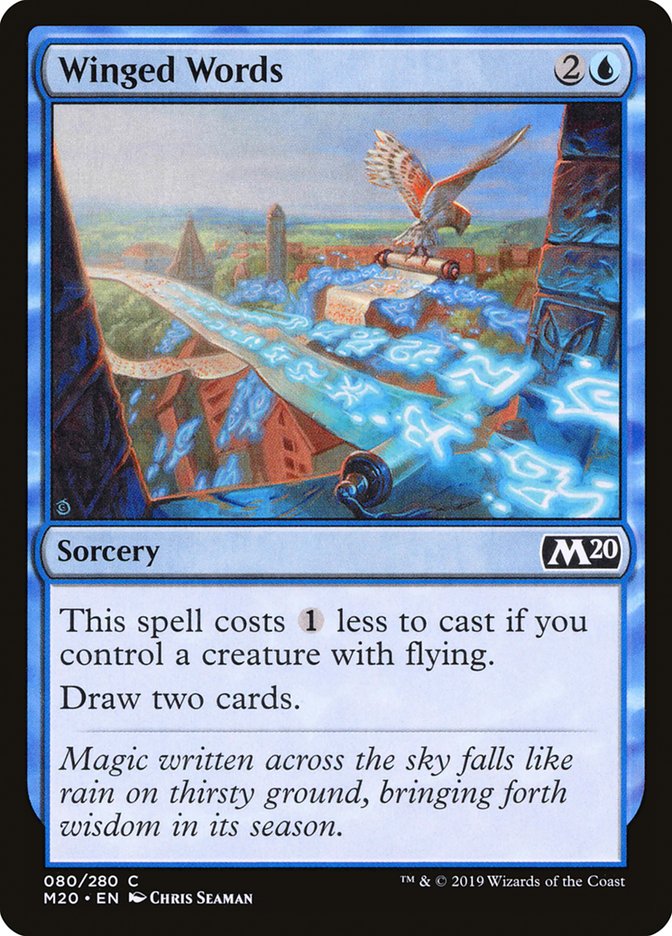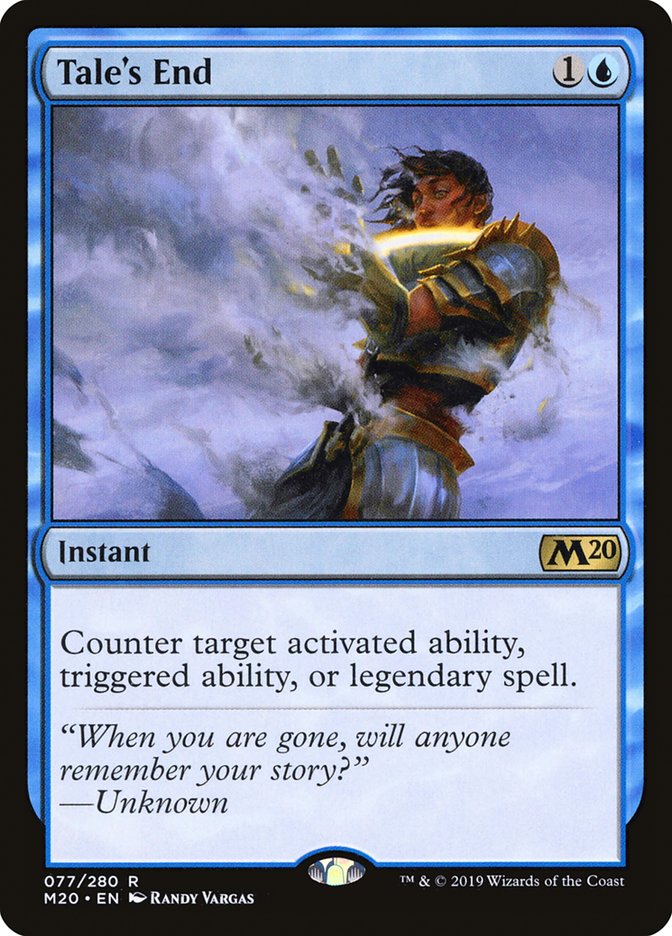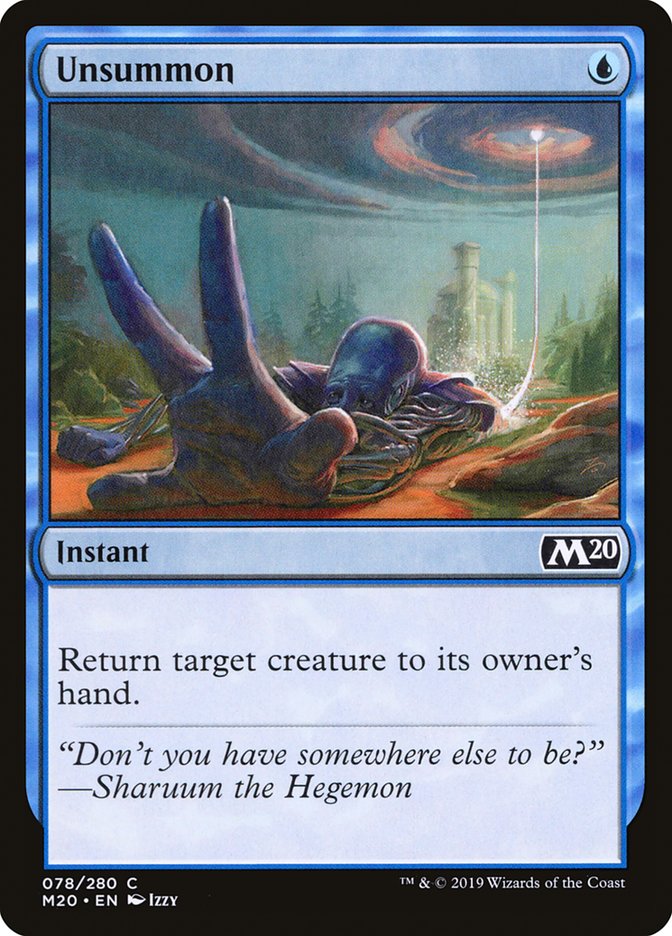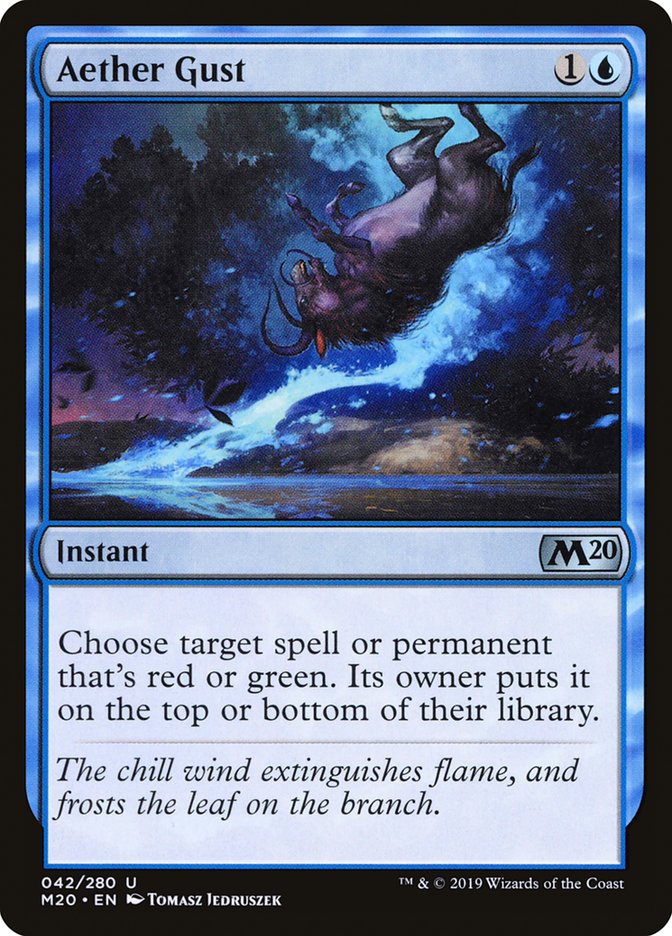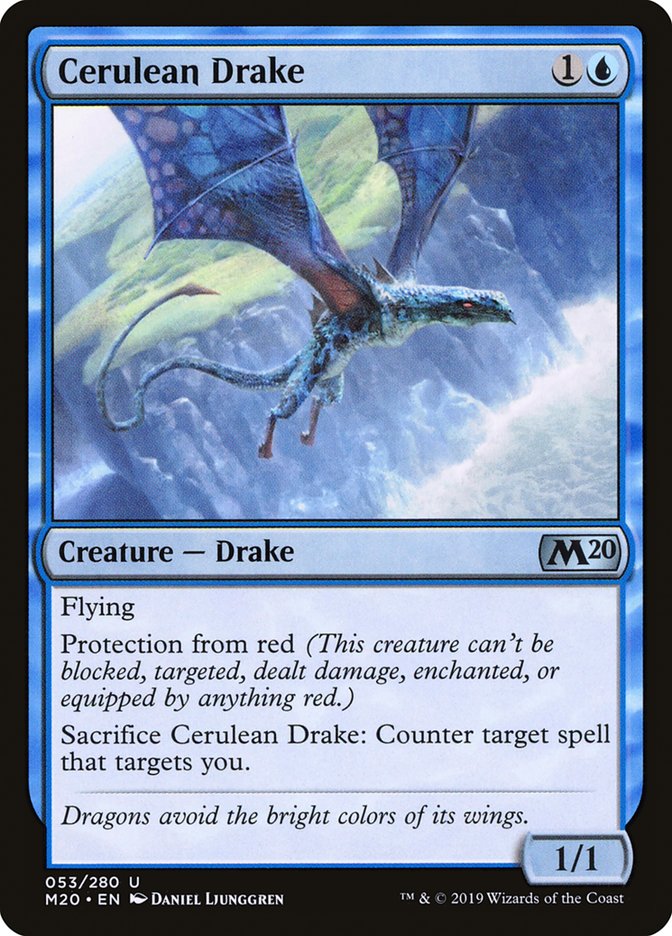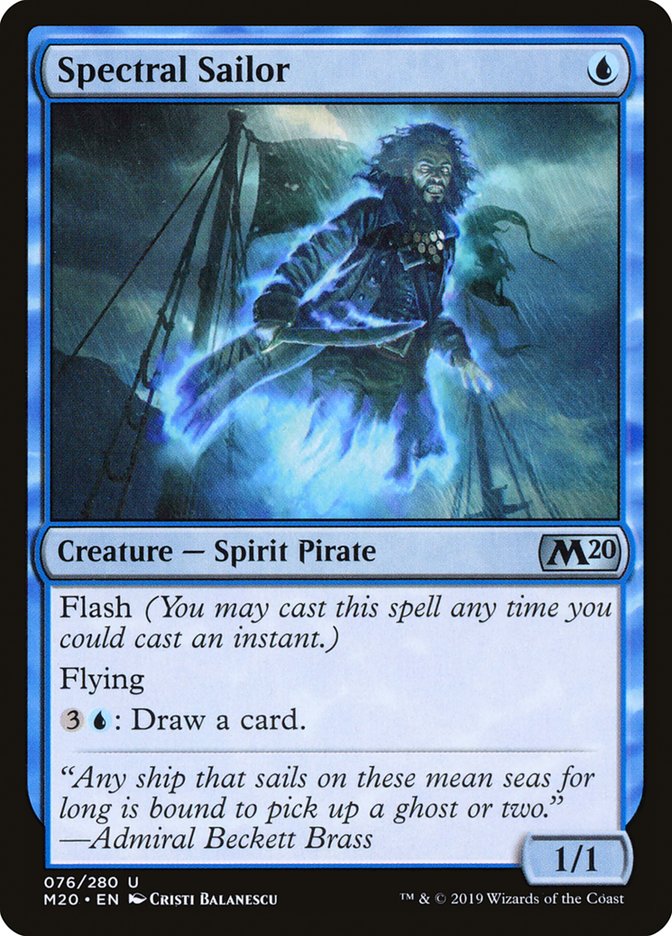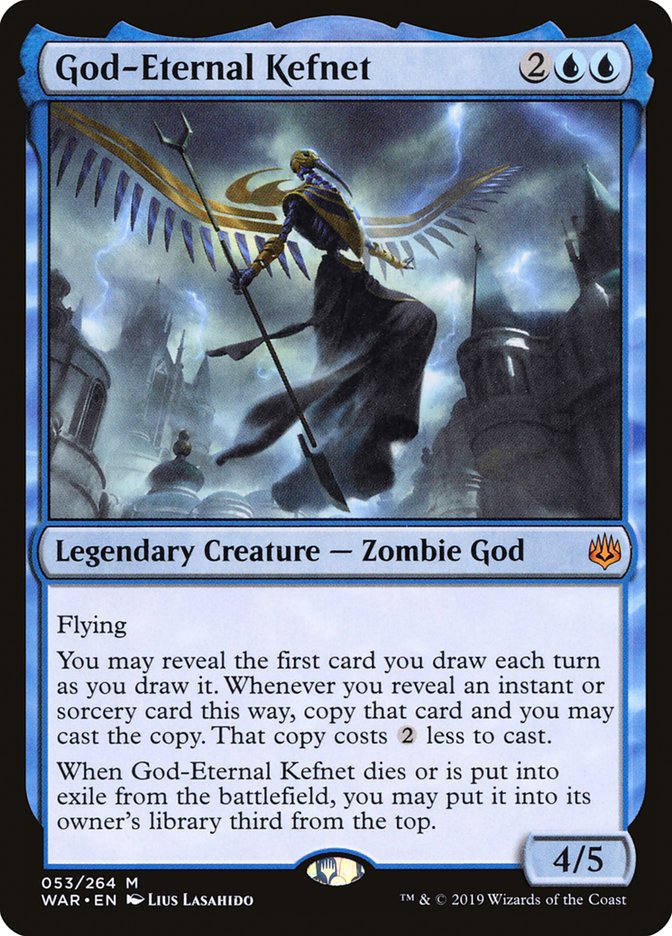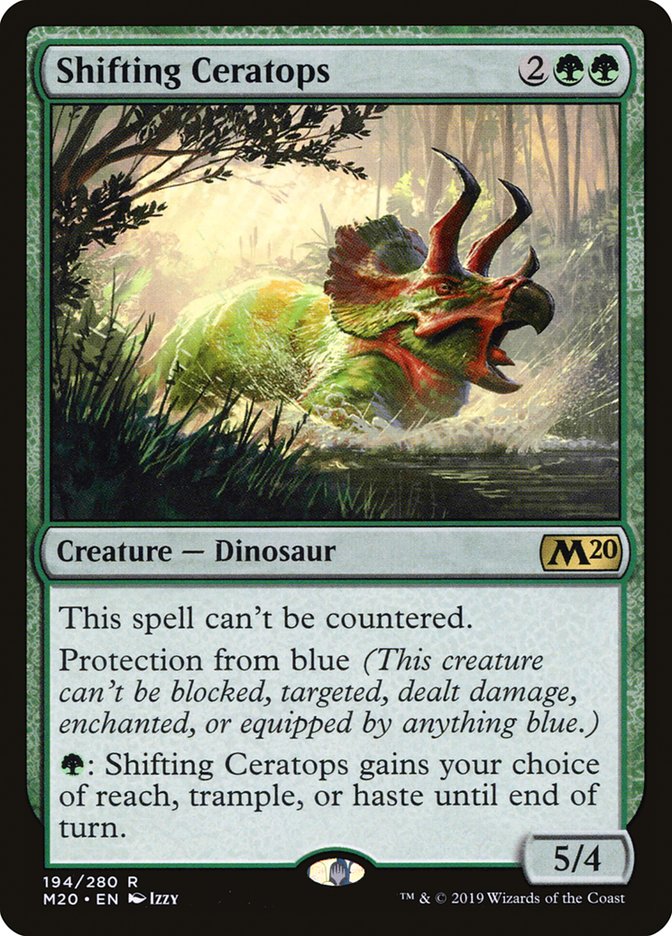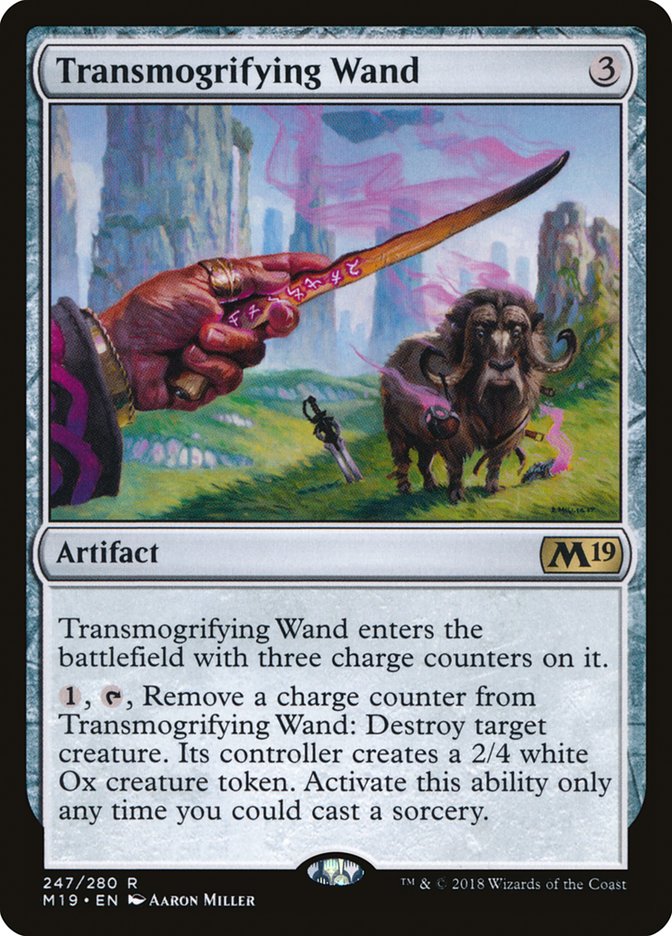The first thing that happens nowadays when a new set is previewed is that I get tagged in a bunch of Tweets asking me if a previewed card will see play in Mono-Blue Aggro. Then come a bunch of questions about when my article talking about updates to Mono-Blue will be coming out.
For War of the Spark, my Mono-Blue update article came somewhat late in to the season, as I was initially doubtful in preview season itself that the deck would be good enough anymore. Blast Zone and Teferi, Time Raveler both seemed incredibly threatening, and the only cards that Mono-Blue really gained from the set were a couple of fine but unexciting sideboard cards in Kasmina’s Transmutation and God-Eternal Kefnet.
As it happened, Mono-Blue was still good against decks like Simic Nexus and the myriad Esper decks despite Blast Zone and Teferi seeing play, and the real thing holding the deck back was the rise of Gruul and Izzet Phoenix – both incredibly tough matchups – and the shift in Mono-Red away from Risk Factor and towards Experimental Frenzy, as the jump-start on Risk Factor telegraphs when you need to have countermagic open, whereas Frenzy is always ready to punish you the moment you tap out for a Tempest Djinn. Even despite the metagame still being far from ideal for the deck, it still won one of the two Red Bull Untapped Magic Arena qualifiers, and I think it was at least a bit underrated throughout War of the Spark Standard.
So what’s different this time around? Why am I so excited to write about Mono-Blue with the release of Core Set 2020? The new tools introduced for Mono-Blue in this set are pretty amazing. Core Set 2020 features new staples of the archetype, as well as incredibly impactful sideboard cards that go some way towards helping solve problem matchups. Whilst I can’t promise Mono-Blue will become Tier 1 again like it was for much of Ravnica Allegiance Standard, the deck is certainly being given a fighting chance and I’m very excited to work on it.
Mono-Blue’s New Toys
Like with my previous update to the deck, I’m going to start this article by going over every single card people have been asking me about, from worst to best.
Mono-Blue is in the market for 1/1 flyers with upside, so it’s easy see why people like the idea of playing Faerie Miscreant. It’s just so much worse than the other options, though. Siren Stormtamer is a pseudo-counterspell that enables Wizard’s Retort and allows you to fight removal even when there’s a Teferi, Time Raveler on the battlefield; Pteramander adapts into an actual Dragon in the late-game; and Spectral Sailor is also quite wonderful for reasons I’ll go over soon. The dream on Faerie Miscreant is that you draw a pair of them, that the first one doesn’t die despite you playing a deck where people are highly incentivised to kill everything on sight, and then your reward is that you get to draw a card.
I can see a world in which you make a build of Mono-Blue Aggro with less lands, a lower curve, and more one-drops, and there Faerie Miscreant could have a home, but it’s very hard to have more than ten or eleven one-drops in your deck if you’re planning on playing Tempest Djinn. In that case, Faerie Miscreant just isn’t as good as the other options.
Mu Yanling, Sky Dancer is a bit of a sad case of the metagame likely just being too hostile to her being played in this deck despite the card itself being quite strong. It’s easy to imagine a metagame where the card would have a home as a sideboard card; in fact, in Ravnica Allegiance Standard I would have happily replaced the Jace, Cunning Castaway in my sideboard with Yanling, as she is even better against those age-old iterations of Esper than Jace was, since her +2 makes an opposing Thief of Sanity irrelevant.
Yanling, and planeswalkers in general, are unexciting in Mono-Blue against Esper Hero since Hero of Precinct One is so good at pressuring your planeswalker. The question is then how good is the card against Esper Control, and I fear that there it just lines up too poorly against Teferi, Time Raveler due to how brutal having a token bounced is. It’s plausible that this doesn’t matter too much, since the gameplan is to make sure a Teferi never resolves in the first place, but I’m already trimming Tempest Djinns against Esper Control to help make sure I can keep Teferi at bay, and adding a different three-mana sorcery speed threat doesn’t really help with that approach.
On top of that, I think Mono-Blue Aggro is actually pretty good against the current iterations of Esper Control, unlike in Ravnica Allegiance Standard where the matchup was a lot tougher and I valued having access to a planeswalker out of the sideboard, so I’m not too invested in the idea of a dedicated sideboard card for that matchup anyway.
I was pretty excited to get to preview the reprint of Dungeon Geists, as I really love the card, and if Standard looked a bit different, it’s easy to imagine the card being excellent out of the sideboard of Mono-Blue. The fact that a lot of the creature decks happen to also be Lightning Strike decks is quite awkward for this card, though.
So is the manner in which Teferi, Time Raveler encourages all your opponents to play creatures that give their value up front with enters-the-battlefield effects and such, rather than playing the sort of good-on-rate creatures that Dungeon Geists can punish, such as Steel Leaf Champion. It seems likely to me that, like with Yanling, this just isn’t the right Standard format for Dungeon Geists despite the card being quite powerful.
Merfolk Trickster has never been great at being a consistently good attacker. Against decks like Esper Control or Simic Nexus, having access to a 2/2 that allows you to leave open countermagic on your opponent’s turn is great, but against decks like Mono-White Aggro, Mono-Red Aggro, or Wildgrowth Walker decks, you’re largely playing the card for its enters-the-battlefield trigger and as a blocker, since as an attacker it often just can’t break through on the ground.
Brineborn Cutthroat is a very sweet card, and I imagine it excels against decks like Esper Control, Simic Nexus, and the mirror, but the matchups where your countermagic is at its best are typically matchups you’re already happy to be playing. Against the creature decks, this card is pretty uninspiring as a defensive body, and it faces the same issues of not being able to attack well that Merfolk Trickster can struggle with.
Chart a Course was always secretly kind of bad, but it was at least fine at the role of being a filler card in your maindeck for when you can’t afford to overload on certain kinds of interaction in pre-sideboard games, and for when you don’t have enough sideboard cards in certain matchups.
Winged Words is functionally incredibly similar to Chart a Course and I have a slight preference for the new card, especially now that you have access to an additional flying one-drop, as the card is a better Turn 3 play alongside a one-drop and plays better than Chart a Course does when you’re holding your Tempest Djinn back on defence. Realistically it won’t matter too much which of these two options you choose to put in that slot.
I was always very down on the idea of playing Repudiate to combat Blast Zone, as the card is just incredibly narrow. The games where your opponent didn’t draw a Blast Zone, the best you could hope for off Repudiate was to counter a Tamiyo, Collector of Tales activation, which is a very unexciting use of a card.
Tale’s End solves this problem, though. Against a deck like Simic Nexus, you get to bring in the card to counter Blast Zone activations, but in a pinch, you can happily stop Tamiyo, Search for Azcanta, or Nissa, Who Shakes the World from resolving. Meanwhile, it’s a perfectly reasonable sideboard card in other matchups. Against Esper Control it can counter Search for Azcanta, Oath of Kaya, or Lyra Dawnbringer in addition to that deck’s myriad planeswalkers. It is worse than a fifth Negate would be, but not by so much that you aren’t still excited to be bringing it in during sideboarding.
Of note, Tale’s End is very good at countering Chandra, Awakened Inferno activations. This particular iteration of Chandra is pretty scary due to her being uncounterable, but if you can Tale’s End the first use of a minus ability from her, you can often kill her the very next turn.
Unsummon is a key example of a tempo-oriented card and is something Mono-Blue has been sorely missing. Exclusion Mage and Callous Dismissal are both cards I’ve played in the deck before and have never been excited about, but the difference a mana or two makes here, plus the difference being an instant makes as well, is huge.
Unsummon creates massive tempo blow-outs when you’re ahead, lets you catch up should you fall behind (bouncing Runaway Steam-Kin once it has accrued a couple of counters has felt particularly impactful to me), and is good for helping you deal with any problematic threats that have slipped through your countermagic, as you can bounce them back to your opponent’s hand with a Wizard’s Retort at the ready for the creature’s return. It’s hard to play many copies of this card, as in the games where you don’t have a Curious Obsession active the card disadvantage can definitely hurt, but Unsummon is a very good role-player in the deck.
The fact that Aether Gust often feels like a Time Ebb is certainly quite awkward at times – yes, you send their threat back, but if it was so problematic, you have to have a plan ready to either kill your opponent very soon or to deal with the threat upon its return. That said, the vast majority of spells that have bothered me in the last few months are red – Rekindling Phoenix, Experimental Frenzy, Runaway Steam-Kin, Skarrgan Hellkite, Crackling Drake.
I’ve had plenty of times where delaying that threat for one more turn really would have been enough, and plenty of times where I actually had the counterspell ready for my opponent’s Frenzy but had to tap out instead to develop a defensive body, letting the Frenzy resolve in the process. In this situation, being able to then use an Aether Gust to force my opponent to recast the Frenzy into my counterspell would have been ideal.
This card can be awkward, but it solves just enough major problems just well enough that I still like it a lot regardless. It also importantly interacts on the stack with a bunch of the uncounterable spells in the format like big Chandra, Shifting Ceratops, and even Niv-Mizzet, Parun, should that card ever see a comeback.
Between Cerulean Drake and Aether Gust, the Mono-Red Aggro matchup might actually be good for Mono-Blue now, which feels weird to say. Saying the “protection from red” creature is good against the red aggressive deck doesn’t really feel like what I’m paid to tell you, but on defence this card gains just absurd amounts of life, and on offence this card wears a Curious Obsession better than anything else doing its best True-Name Nemesis impression.
Now we get to the real prize. Spectral Sailor might just be kind of busted in this deck. It’s still early days, but a bit of me feels like it may be vying for the title of best one-drop in the deck. In your developing turns, the flash on it offers you an amazing level of flexibility, letting you waste your opponent’s mana by not letting them use removal on your turn, catching your opponent off-guard sometimes (especially if they don’t realise you’re on Mono-Blue), and letting you hold up countermagic whilst still threatening to develop your battlefield if you don’t need to counter something.
This last point is particularly relevant, as I have lost a lot of games due to feeling like I needed to tap low on mana in order to develop a threat instead of holding up a counterspell, only to get immediately punished on my opponent’s turn, and this just doesn’t happen when the threat you’re developing is a Spectral Sailor.
On top of that, the activated ability is kind of unreasonable. You reach a point in the game against slower decks like Esper Control where Spectral Sailor becomes your actual best draw. It begins at the point in the game where you’re at six lands or so and can go “End of turn cast my Spectral Sailor, draw a card, use my Dive Down to protect it from your removal spell, and force you to have a second answer or the game ends.” I’ve had some games go very long in matchups like that, though, and a Spectral Sailor in hand with nine lands on the battlefield represents a guaranteed three-for-one.
You also just lose fewer games to flooding now. Even against a deck like Mono-Red, I lost a lot of games where I would stabilise, but I couldn’t reasonably kill my opponent because I needed all my creatures on defence, and they just topdecked better. Having a bunch of your threats also be Jayemdae Tome is huge in helping prevent this, which makes Spectral Sailor an incredible addition.
My Current List
All of this leads me to my present build of the deck:
Spells (22)
- 1 Unsummon
- 4 Opt
- 1 Negate
- 3 Spell Pierce
- 1 Lookout's Dispersal
- 3 Dive Down
- 4 Curious Obsession
- 4 Wizard's Retort
- 1 Winged Words
Sideboard

The one-drops are all so good now that I’m up to ten of them and I wouldn’t mind fitting in a third Pteramander too for additional closing power, though I don’t really know how to accomplish that. Having a total of eight Pirates in the deck with the addition of Spectral Sailor means Lookout’s Dispersal is now actually a pretty appealing card, and I could definitely see building the deck in a way that leans into this more, though I’ve been pretty happy with just the one copy for now. Unsummon has replaced Essence Capture in my maindeck, since Unsummon is not a dead card against creatureless decks and being able to save one of your threats from a removal spell, or even bounce a Nissa-animated-land against a deck like Simic Nexus, is valuable.
I’ve abandoned God-Eternal Kefnet in the sideboard, since I was largely playing that card to help in the Mono-Red and Gruul matchups. Those decks now have Fry and were even playing Fight with Fire recently too, which makes Kefnet’s Lava Coil resilience much less appealing, whilst Aether Gust and Cerulean Drake help enough that I think there’s also just less of a need of a tool like Kefnet.
The rest of the sideboard is still in flux and will take a while to tune fully whilst we wait to see how the metagame shakes outs. If Mono-Red continues to not be very popular, I would look to trim a Drake, and another Tale’s End may become necessary if big Chandra or Blast Zone sees an uptick in play.
And as for Transmogrifying Wand…
The Ceratops in the Room
Shifting Ceratops is, shall we say, a problem: uncounterable, with protection from your deck and even reach to boot. The scariest thing about Shifting Ceratops is its ability to act as a Moat against you, making it so hard to make profitable attacks when it sits back on defence, ready to reach up and snatch your flyers out of the air.
Honestly, if over the next couple of weeks the metagame shakes out in such a way that Shifting Ceratops is extremely popular and sees a lot of maindeck play, I would be pretty hesitant to register Mono-Blue, and at the very least would be (sadly) eyeing up Mist-Cloaked Herald as a way to attack past Ceratops’s Moat mode. As long as the card is just seeing moderate amounts of sideboard play, though, I believe it is actually manageable. Sometimes your opponent won’t draw it, sometimes you’ll have a timely Aether Gust at the ready, and the rest of the time, I’ll be looking to Transmogrifying Wand to aid me.
This answer to Ceratops was suggested to me by someone in my Twitch chat and it is honestly kind of perfect. To play the Wand and cash in your first activation, you’re trading even on mana with the Ceratops, but decks that play Shifting Ceratops will often have a bunch of other expensive green creatures, making the next two activations of this card pretty powerful follow-ups. It’s certainly a clunky card, and one I avoided playing in my sideboard for a long time, but I have been very happy with it so far in testing and would strongly consider fitting in a second copy in the sideboard when expecting to have to turn a bunch of Dinosaurs into Oxen.
Other Routes
It would be remiss of me not to mention that some people have been moving away from Tempest Djinn. I’ve seen a few different people talk about this now, and it was something I tried out myself on stream back when the set first hit Magic Arena. The idea is that you have such a critical mass of good one-drops now that you can afford to cut Tempest Djinn whilst still having a good threat density. Tempest Djinn is pretty unexciting anyway against the aspect of the format that’s all about going over the top of each other, as in those matchups you want to stay low to the ground and can struggle to justify tapping out for a threat instead of holding open countermagic.
I understand the logic of this, especially considering I’m the person who is most known for being willing to sideboard out Tempest Djinn. That said, whilst I certainly intend to try out this style of list more, for now I am still a bit sceptical. Tempest Djinn, alongside Curious Obsession, is one of the two cards in your deck with enough raw power to be able to carry a game on its own, which I think is important considering how weak some of the other cards you’re playing with can look at times.
I’ve also historically found Tempest Djinn incredibly important against the aggressive decks in the format and can’t imagine how much harder those matchups must be without access to this card. Maybe this doesn’t matter too much whilst people are excited to try out all the new cards, but once things settle down, I expect the aggressive decks to be as good as they’ve always been for the last few months, and paying them some amount of respect feels important to me.
Regardless of how you’re building Mono-Blue, landing that Turn 2 Curious Obsession with Spell Pierce protection will always be an amazing feeling, and I wish you all your own personal Howling Mine whilst you’re out there battling in this new Standard format!


